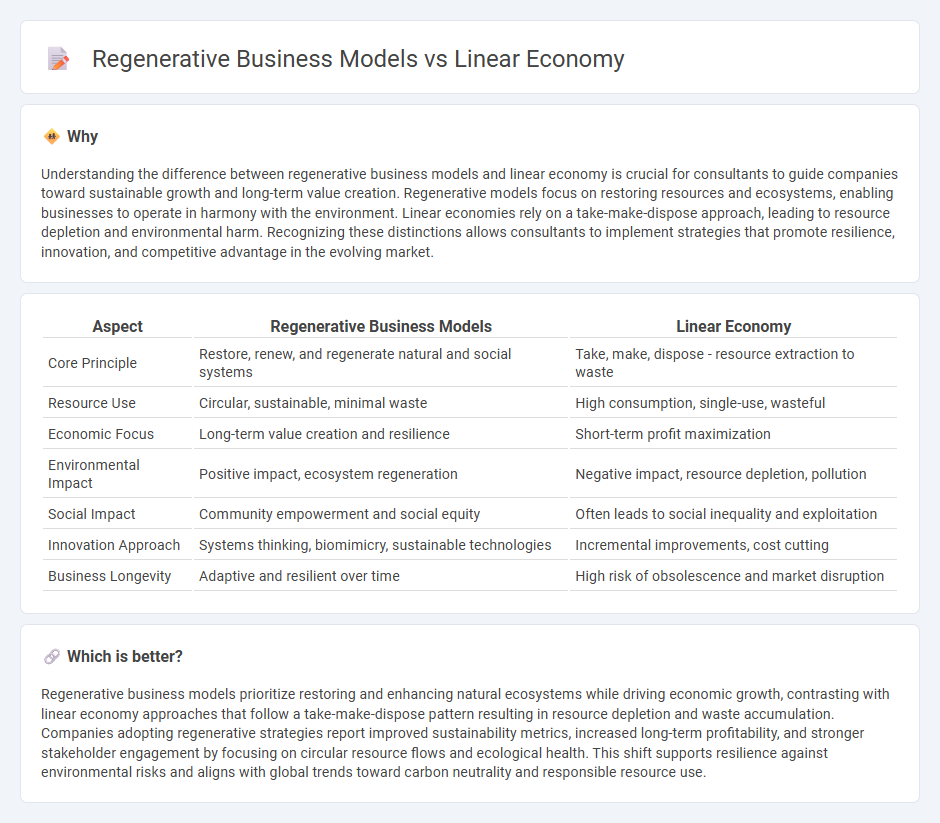
Regenerative business models prioritize circularity, resource renewal, and long-term ecological balance, contrasting sharply with traditional linear economy systems that follow a take-make-waste approach. Companies adopting regenerative strategies enhance sustainability by restoring natural ecosystems and promoting economic resilience. Explore how consulting can guide the transition from linear to regenerative business models for lasting impact.
Why it is important
Understanding the difference between regenerative business models and linear economy is crucial for consultants to guide companies toward sustainable growth and long-term value creation. Regenerative models focus on restoring resources and ecosystems, enabling businesses to operate in harmony with the environment. Linear economies rely on a take-make-dispose approach, leading to resource depletion and environmental harm. Recognizing these distinctions allows consultants to implement strategies that promote resilience, innovation, and competitive advantage in the evolving market.
Comparison Table
| Aspect | Regenerative Business Models | Linear Economy |
|---|---|---|
| Core Principle | Restore, renew, and regenerate natural and social systems | Take, make, dispose - resource extraction to waste |
| Resource Use | Circular, sustainable, minimal waste | High consumption, single-use, wasteful |
| Economic Focus | Long-term value creation and resilience | Short-term profit maximization |
| Environmental Impact | Positive impact, ecosystem regeneration | Negative impact, resource depletion, pollution |
| Social Impact | Community empowerment and social equity | Often leads to social inequality and exploitation |
| Innovation Approach | Systems thinking, biomimicry, sustainable technologies | Incremental improvements, cost cutting |
| Business Longevity | Adaptive and resilient over time | High risk of obsolescence and market disruption |
Which is better?
Regenerative business models prioritize restoring and enhancing natural ecosystems while driving economic growth, contrasting with linear economy approaches that follow a take-make-dispose pattern resulting in resource depletion and waste accumulation. Companies adopting regenerative strategies report improved sustainability metrics, increased long-term profitability, and stronger stakeholder engagement by focusing on circular resource flows and ecological health. This shift supports resilience against environmental risks and aligns with global trends toward carbon neutrality and responsible resource use.
Connection
Regenerative business models prioritize restoring and renewing resources, contrasting with the linear economy's take-make-waste approach. Consulting firms help organizations transition to regenerative practices by redesigning supply chains and integrating circular economy principles. This shift enhances sustainability, reduces environmental impact, and drives long-term value creation.
Key Terms
Resource Flow
Linear economy relies heavily on a one-way flow of resources, where raw materials are extracted, transformed into products, used, and then discarded as waste, creating significant environmental strain. Regenerative business models prioritize circular resource flows by designing products and systems that restore, renew, and minimize waste through reuse, recycling, and continuous replenishment of natural capital. Explore how shifting from a linear to a regenerative resource flow can transform sustainability practices and drive long-term economic resilience.
Circularity
Linear economy relies on a take-make-waste approach, leading to resource depletion and environmental harm. Regenerative business models prioritize circularity by designing products for reuse, repair, and recycling to create closed-loop systems that restore natural resources. Explore how shifting towards circular economies can drive sustainability and innovation in diverse industries.
Value Creation
Linear economy models prioritize value extraction through resource consumption and waste generation, leading to environmental degradation and limited long-term sustainability. Regenerative business models emphasize restoring ecosystems, circular resource use, and creating shared value for communities and stakeholders, enhancing resilience and economic viability. Discover how shifting towards regenerative practices can drive sustainable growth and innovation.
Source and External Links
Linear Economy Explained - EFS Consulting - The linear economy operates on a "Take-Make-Dispose" principle involving high resource consumption, short product lifespans, planned obsolescence, and significant environmental impact due to waste and emissions.
What is a Linear Economy? | Rome Business School - A linear economy follows a "take, make, dispose" model where raw materials are extracted, products are manufactured and consumed, and then discarded, leading to environmental degradation and resource depletion.
Linear Economy Definition - Arena Solutions - This "take-make-waste" model dominates industrial production, emphasizing continuous consumption without reuse, contrasting with a circular economy that promotes sustainability through repair and recycling.
 dowidth.com
dowidth.com